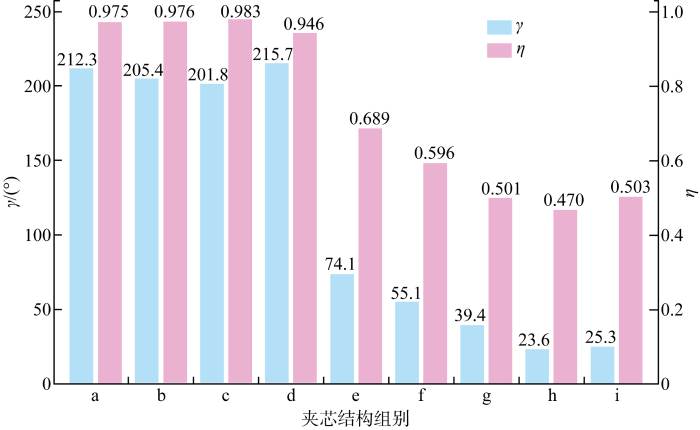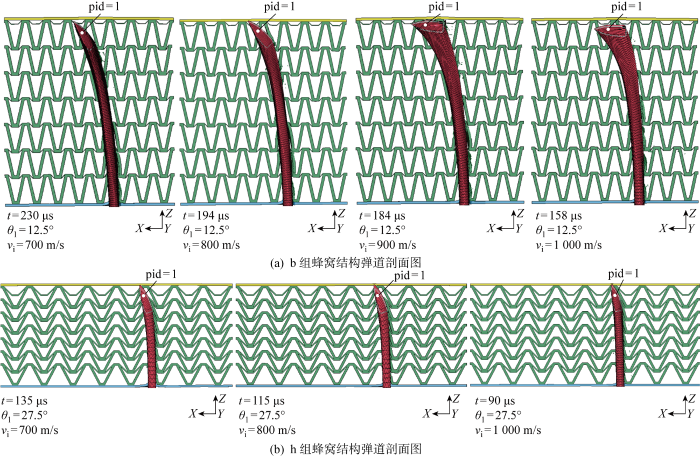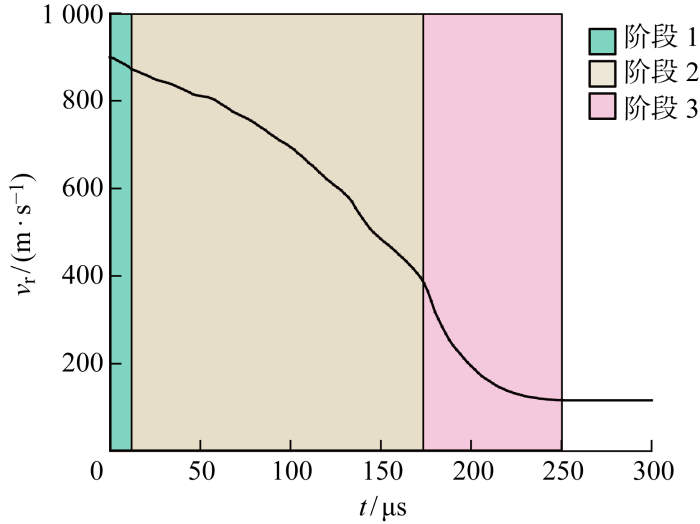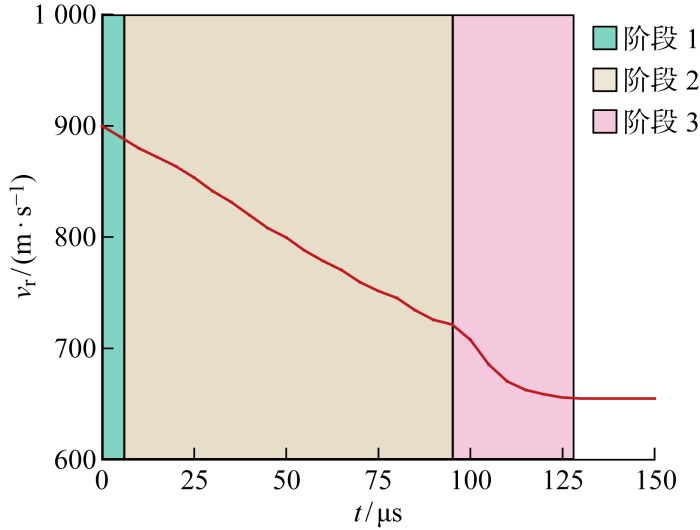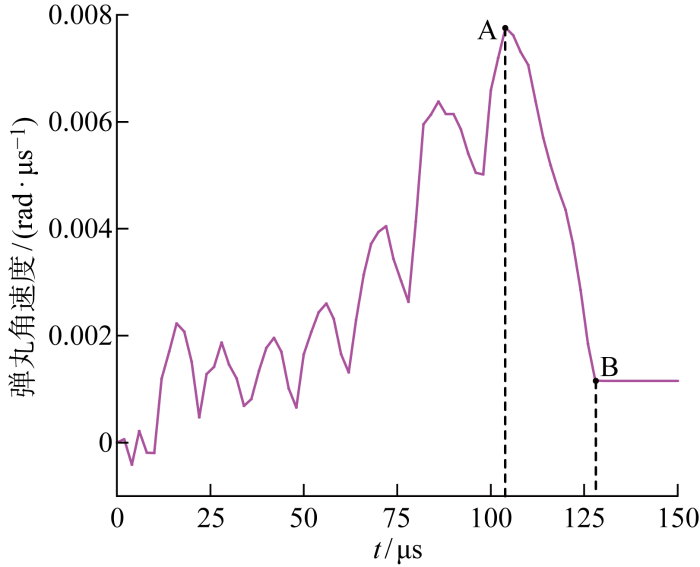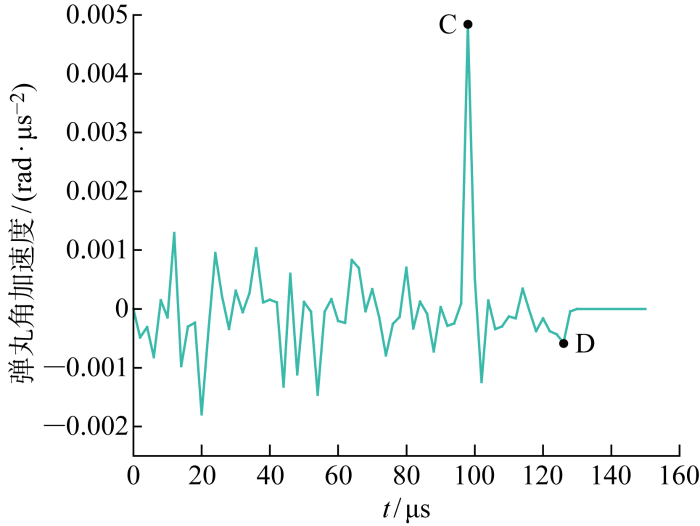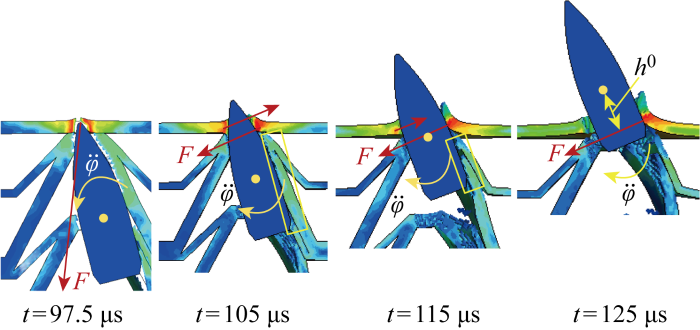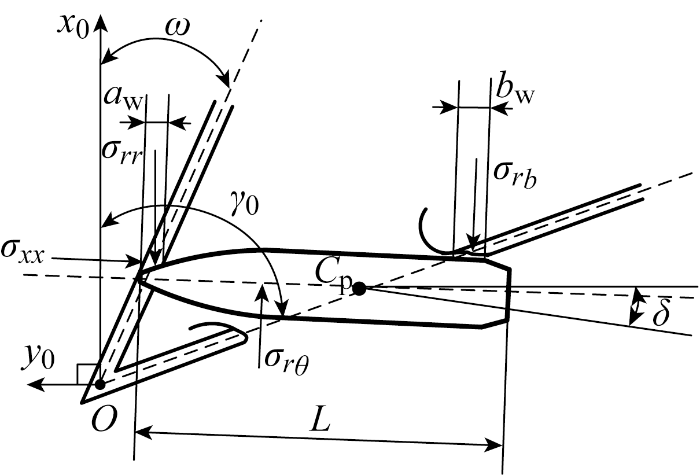Wang等[9]通过仿真,对平头弹丸侵彻正六边形、内凹六边形、方形等6种蜂窝结构面外抗侵彻性能进行研究.发现内凹六边形的胞元壁内凹导致材料利用不充分,其在6种结构中抗侵彻性能最差.刘彦等[10]通过弹道枪实验和数值模拟法研究球形弹丸侵彻内凹六边形蜂窝夹芯结构的抗侵彻性能,因内凹六边形存在NPR效应,抗侵彻能力优于泡沫铝夹芯及正六边形夹芯.Qi等[11]利用数值模拟对比了正六边形、内凹六边形等不同夹芯结构的抗侵彻性能,由于NPR效应产生结构致密化,内凹六边形抗侵彻性能更好.杨德庆等[12]提出一种内凹六边形NPR蜂窝夹芯防护结构,研究了胞元参数对侵彻性能的影响.发现蜂窝夹芯的存在使弹体侵彻路径上的结构质量减小,导致防护效果不佳.Hassanin等[13]制备出一种内凹六边形NiTi合金蜂窝夹芯结构,研究该结构的抗侵彻性能,发现内凹六边形NiTi合金蜂窝夹芯结构的比吸能是传统钢板结构的5倍.蒋欣程[14]研究了双箭头蜂窝夹芯参数对弹道极限的影响,发现存在一个特殊的胞元夹角使得弹道极限最大.
本文在文献[16]的基础上模拟小口径弹丸高速侵彻双箭头NPR蜂窝夹芯结构.对结构的能量吸收及子弹的弹道特性进行研究及参数化分析,辨析胞元参数对侵彻性能的影响,推导了双箭头NPR蜂窝夹芯结构在小口径弹丸高速侵彻下的力学模型,为防护设计提供参考.
1 数值模拟
1.1 弹丸与胞元结构模型
图1
αC和βC分别取0.10和0.25,夹角θ1为研究变量,夹角θ2取45°,长胞元壁L2取17 mm,只要给定变量θ1就能确定双箭头NPR胞元结构尺寸.当胞元受外力作用时,水平胞元壁L1与L4的间距将会变化,胞元的横向距离也同趋势变化.因此多个胞元构成的蜂窝结构也具有受到纵向压缩时横向发生收缩,受到纵向拉伸时横向发生扩张的负泊松比性质[19].
相对密度指蜂窝结构的等效密度相对于所用基体材料的密度[20].二维双箭头蜂窝结构相对密度的表达式为
本研究夹角θ1取值范围为10°~30°,共9组(a~i).双箭头NPR蜂窝夹芯结构由8×7形式的单胞结构蜂窝、前板、背板3部分组成.面板厚度均为1.5 mm,夹芯结构的厚度、宽度根据θ1值不同而改变.蜂窝夹芯结构面外高度为14 mm,夹角θ1具体值及对应蜂窝的相对密度参数列于表1.
表1 蜂窝模型参数
Tab.1
| 组别 | θ1/(°) | ρ2RD | 厚度/mm | 质量/g |
|---|---|---|---|---|
| a | 10.0 | 0.319 8 | 122.9 | 179.0 |
| b | 12.5 | 0.313 9 | 117.1 | 187.6 |
| c | 15.0 | 0.312 4 | 111.3 | 195.4 |
| d | 17.5 | 0.314 8 | 105.2 | 206.5 |
| e | 20.0 | 0.321 1 | 99.0 | 108.4 |
| f | 22.5 | 0.331 5 | 92.6 | 113.9 |
| g | 25.0 | 0.346 8 | 86.1 | 119.6 |
| h | 27.5 | 0.367 8 | 79.5 | 125.3 |
| i | 30.0 | 0.396 1 | 72.8 | 130.8 |
图2
1.2 有限元模型
弹丸侵彻双箭头NPR蜂窝夹芯结构的数值模拟采用LS-DYNA软件进行.考虑到该模型的形状及载荷具有对称性,建立三维模型的1/2对称模型以减小计算规模,绝对坐标系的Y轴垂直于对称面.在对称面使用对称边界条件,建模采用单位为g-cm-us.弹丸、面板、芯层均使用实体单元建模 (*SECTION_SOLID).本研究不考虑侵彻过程中弹丸自身的变形,故弹丸采用(*MAT_RIGID)赋予刚体属性.对模型背板两端施加完全固定约束,约束位置如图3所示,芯层与上下面板之间连接处设置绑定接触(*TIED_SURFACE_TO_SURFACE).
图3
使用六面体网格对模型进行划分,弹丸与面板网格的尺寸保持不变,均为0.4 mm.划分芯层网格时,确保胞元壁厚度方向平均存在5层网格.网格分析表明,5层网格既可以保证较好的计算精度,亦能控制计算成本.所有网格雅可比系数大于0.7,通常雅可比系数大于0.7时可以认为有限元模型的网格质量较为优良,由网格划分产生的误差对数值计算的准确性影响较低.所有单元均应用沙漏控制 (*CONTROL_HOURGLASS)以避免网格单元的零能模式,提高数值模拟结果的可信度.
将弹体与芯层、前板与背板之间接触设置为侵蚀接触(*CONTACT_ERODING_SURFACE_TO_SURFACE),以模拟胞元贯穿失效.双箭头芯层自身设置为自接触(*AUTOMATIC_SINGLE_SURFACE).当胞元的塑性应变达到失效值时,相应单元被删除,从而形象地模拟侵彻时的结构损伤及变形.
1.3 材料参数与状态方程
式中:A1、B1、C为材料输入常数;
式中:E为初始内能;C0为冲击绝热曲线的截距;S1、S2、S3为冲击绝热曲线斜率的系数;γ0为Gruneisen系数;a为γ0的1阶体积修正系数;ρ0为材料密度;μ为材料的受压系数.
J-C模型自带损伤断裂准则,损伤断裂模型定义为[11]
式中:σ*为压力与有效压力σeff之比,σ*=p/σeff; D1~D5为断裂常量.当破坏参数D达到1时即认为产生断裂:
式中:Δ
表2 45#钢、2024铝Johnson-Cook本构参数
Tab.2
| 材料 | ρ/(g·cm-3) | A1/MPa | B1/MPa | C | n | m | Tm/K | Tr/K |
|---|---|---|---|---|---|---|---|---|
| 45#钢 | 7.82 | 507 | 320 | 0.064 | 0.28 | 1.06 | 1 795 | 300 |
| 2024铝 | 2.78 | 265 | 426 | 0.015 | 0.34 | 1.00 | 933 | 300 |
表3 45#钢、2024铝Gruneisen参数
Tab.3
| 材料 | C0/(cm·μs-1) | S1 | γ0 |
|---|---|---|---|
| 45#钢 | 0.456 9 | 1.490 | 2.17 |
| 2024铝 | 0.532 8 | 1.338 | 1.97 |
表4 45#钢、2024铝Johnson-Cook失效参数
Tab.4
| 材料 | D1 | D2 | D3 | D4 | D5 |
|---|---|---|---|---|---|
| 45#钢 | 0.10 | 0.76 | 1.57 | 0.005 | -0.84 |
| 2024铝 | 0.13 | 0.13 | -1.50 | 0.011 | 0.00 |
1.4 数值模型验证
图4
图4
弹体垂直侵彻2024铝靶数值模型
Fig.4
Finite element model of projectile body vertical penetration into 2024 aluminum target
图5
图5
与2024铝靶垂直侵彻结果对比(mm)
Fig.5
Normal penetration data of 2024 aluminum targets (mm)
2 数值模拟结果
2.1 双箭头NPR夹芯结构动能吸收率
评估NPR夹芯结构对弹丸的动能吸收可以用动能吸收率η来表示[27]
式中:Et为夹芯结构吸收的动能;Ek为弹丸初始动能;mp为弹丸质量;vi为弹丸初始速度;vr为弹丸残余速度.
表5 弹体侵彻NPR夹芯结构的仿真结果
Tab.5
| vi/(m·s-1) | 组别a | 组别b | 组别c | |||||
|---|---|---|---|---|---|---|---|---|
| vr/(m·s-1) | η | vr/(m·s-1) | η | vr/(m·s-1) | η | |||
| 300 | 0 | 1 | 0 | 1 | 0 | 1 | ||
| 400 | 0 | 1 | 0 | 1 | 0 | 1 | ||
| 500 | 0 | 1 | 0 | 1 | 0 | 1 | ||
| 600 | 0 | 1 | 0 | 1 | 0 | 1 | ||
| 700 | 0 | 1 | 265.24 | 0.856 | 233.41 | 0.888 | ||
| 750 | 0 | 1 | 372.82 | 0.753 | 374.24 | 0.751 | ||
| 800 | 277.78 | 0.879 | 332.41 | 0.827 | 383.00 | 0.770 | ||
| 850 | 437.62 | 0.735 | 65.34 | 0.994 | 381.34 | 0.798 | ||
| 900 | 141.40 | 0.975 | 137.48 | 0.976 | 116.05 | 0.983 | ||
| 950 | 486.52 | 0.737 | 135.29 | 0.979 | 333.83 | 0.876 | ||
| 1 000 | 417.90 | 0.825 | 240.63 | 0.942 | 439.17 | 0.807 | ||
| vi/(m·s-1) | 组别d | 组别e | 组别f | |||||
| vr/(m·s-1) | η | vr/(m·s-1) | η | vr/(m·s-1) | η | |||
| 300 | 0 | 1 | 0 | 1 | 0 | 1 | ||
| 400 | 0 | 1 | 0 | 1 | 0 | 1 | ||
| 500 | 0 | 1 | 0 | 1 | 0 | 1 | ||
| 600 | 56.55 | 0.991 | 212.76 | 0.874 | 142.74 | 0.943 | ||
| 700 | 330.86 | 0.776 | 257.96 | 0.864 | 380.65 | 0.704 | ||
| 800 | 353.59 | 0.804 | 465.31 | 0.661 | 446.26 | 0.688 | ||
| 900 | 207.92 | 0.946 | 501.75 | 0.689 | 571.72 | 0.596 | ||
| 1 000 | 434.12 | 0.811 | 594.57 | 0.646 | 676.91 | 0.541 | ||
| vi/(m·s-1) | 组别g | 组别h | 组别i | |||||
| vr/(m·s-1) | η | vr/(m·s-1) | η | vr/(m·s-1) | η | |||
| 300 | 0 | 1 | 0 | 1 | 0 | 1 | ||
| 400 | 0 | 1 | 0 | 1 | 0 | 1 | ||
| 500 | 0 | 1 | 64.94 | 0.983 | 0 | 1 | ||
| 600 | 300.80 | 0.748 | 301.22 | 0.747 | 286.41 | 0.772 | ||
| 700 | 408.43 | 0.659 | 423.92 | 0.633 | 414.33 | 0.649 | ||
| 800 | 511.09 | 0.591 | 534.17 | 0.554 | 519.61 | 0.578 | ||
| 900 | 635.61 | 0.501 | 654.95 | 0.470 | 634.17 | 0.503 | ||
| 1 000 | 737.72 | 0.455 | 763.98 | 0.416 | 740.85 | 0.451 | ||
图6
图6
双箭头夹芯结构能量吸收率-初始速度曲线
Fig.6
Energy absorption efficiency of double-arrow sandwich structure versus velocity
由图6可知,对于同种蜂窝夹芯结构,η与vi之间并非存在线性关系.在g、h、i组夹芯结构中随着弹丸初速的增加,能量吸收率急剧下降至0.45附近,且它们之间较为接近.e、f组能量吸收率下降较g、h、i组小,f组下降至0.54附近,e组下降至0.64附近.a、b、c、d组随着弹丸初速增加,结构能量吸收率存在先减小后增加的规律;且这4组夹芯结构的能量吸收率均高于0.77,显著优于其余5组结构.因此双箭头NPR蜂窝夹芯结构的抗侵彻能力随着θ1增加而降低.纵观所有曲线,当vi=800~1 000 m/s时,a、b、c、d、e组结构的能量吸收率开始出现波动式增加,且θ1越小波动程度越大.
2.2 双箭头NPR夹芯结构的弹道极限
一般认为结构的弹道极限越高,其抗侵彻能力越强.本研究试图通过弹道极限来评估双箭头NPR夹芯结构的抗侵彻性能,利用Jonal A改进的基于能量守恒和动量定理的R-I公式[28]获取弹道极限,表达式如下
式中: vbl为弹道极限;A、p为模型参数,通过最小二乘法拟合得到.
表6 NPR蜂窝夹芯结构的弹道极限
Tab.6
| 组别 | vb1/(m·s-1) |
|---|---|
| a | (750, 800) |
| b | (600, 700) |
| c | (600, 700) |
| d | 557.64 |
| e | 532.24 |
| f | 569.87 |
| g | 488.44 |
| h | 494.41 |
| i | 494.41 |
2.3 弹丸的弹道特性
本研究采用对称边界条件,弹丸偏转及速度矢量变化始终在XtZt平面内.定义弹丸绕自身质心Yt轴转动的角度γ为偏航角(当前时刻弹体轴线与初始弹体轴线位置夹角,方向符合右手螺旋定则).弹体轴线与速度方向夹角α为攻角,弹速与靶板法线夹角β为着角,弹轴与靶板法线夹角φ为姿态角.如图7所示,此时α、β、φ均为正,满足几何关系:φ=α+β.
图7
图8
图8
弹丸侵彻9组夹芯结构的弹道剖面图
Fig.8
Trajectory profile of projectile penetrating a 9-group sandwich structure
对比弹道剖面图,同一弹丸以同一速度侵彻时,随着θ1逐渐增大,弹丸最终贯穿夹芯结构时的姿态越不稳定.提取弹丸绕自身Yt轴的角位移,如图9所示.发现弹丸偏航角与蜂窝夹芯结构的动能吸收率存在关联,弹丸贯穿姿态越稳定,双箭头NPR蜂窝夹芯结构的能量吸收率就越低.
图9
图9
弹丸偏航角和蜂窝夹芯结构动能吸收率
Fig.9
Bullet yaw angle and kinetic energy absorption rate of honeycomb sandwich structure
将b、h两组弹道剖面对比,如图10所示.随着初始速度的增加,弹丸在未穿透b组结构芯层时姿态角的改变量已经大于90°.而h组弹丸姿态角的变化相对较小,弹道一致性优于b组结构.这是由于h组结构的相对密度大于b组,胞元壁之间的距离较小,限制了弹丸的姿态变化.
图10
弹丸姿态角的改变会导致弹-靶作用面积的改变,进而影响弹丸受到的侵彻阻力[29].a、b、c三组结构中弹丸姿态角变化相对其他组较高,弹丸受到的侵彻阻力变化较大,最终导致弹丸残余速度产生较大波动,这也是2.2节中a、b、c三组弹道极限拟合结果不佳的原因.
3 弹丸侵彻双箭头NPR夹芯结构分析
3.1 侵彻过程分析
图11
图12
在c组结构中,阶段1弹丸速度从900 m/s降至878.99 m/s,该阶段历时10 μs.阶段2弹丸速度从878.99 m/s降至383.06 m/s,该阶段历时165 μs.阶段3速度从383.06 m/s降至116.05 m/s,该阶段历时75 μs.
在h组结构中,阶段1弹丸速度从900 m/s降至879.85 m/s,该阶段历时10 μs.阶段2弹丸速度从879.85 m/s降至717.71 m/s,该阶段历时87 μs.阶段3速度从717.71 m/s降至654.95 m/s,该阶段历时33 μs.
将c、h组不同阶段弹丸损失的动能比例列于表7.发现在双箭头NPR蜂窝夹芯结构中,芯层起到主要吸能作用,背板起到次要吸能作用,而前板对夹芯结构的吸能影响最小.
表7 弹体各阶段动能损失比例
Tab.7
| 组别 | 阶段1/% | 阶段2/% | 阶段3/% |
|---|---|---|---|
| c | 4.7 | 78.6 | 16.7 |
| h | 9.4 | 68.0 | 22.6 |
3.2 弹丸偏转机理分析
图13
图14
由图13可得,弹丸侵彻前板时角速度出现短暂负值,侵彻芯层时弹丸角速度虽有振荡,但恒为正值.这引起α的改变和β的增大,最终导致φ增大使弹丸沿着X正向偏移.
图中A、B两点间弹丸角速度急剧下降,绘制t=105~125 μs时刻的应力云图,如图15所示.发现弹丸周围存在应力分布不均的现象,虽然弹丸的角速度为正,但弹丸受到右侧胞元壁的挤压(黄色线框内)阻碍了弹丸的正向旋转,产生的侧向力矩导致弹丸角加速度为负值,如图14所示,t=105~125 μs时刻内D点加速度值最大.原因是弹丸受到背板的挤压,随着弹丸的运动,侧向力F的作用范围从弹肩移至弹尾,导致力臂h0逐渐增加,力矩也随之增大,故产生的角加速度逐渐增大.在整个侵彻过程中t=97.5 μs时刻C点的角加速度值最大,此时弹丸头部侵彻靶体的厚度是背板厚度与长、短胞元壁厚度的总和,导致弹丸头部存在较大的侵彻阻力,如图15所示.
图15
3.3 弹丸偏转力学模型
弹丸侵彻单个双箭头NPR胞元时的受力状态如图16所示.图中:Cp点为弹丸质心;aw=dtan(α+β),为弹头接触面最大的接触距离;bw=dtan(α+γ)为弹尾接触面最大的接触距离;γ0为外侧边与x0轴夹角;δ为穿透胞元后弹丸的攻角改变量;ω为内侧边与x0轴夹角;σrb为尾部正应力分量.
图16
当弹丸与胞壁接触时,由于材料的屈服作用产生应力,这些应力成为阻力的来源,所以冲击面会对弹丸质心产生力矩作用.接触面弹丸存在头部正应力分量σxx、σrr,尾部正应力分量σrb与周向切应力σrθ.正应力分量会对弹丸质心产生翻转力矩,切应力则不会[23].头部径向应力σrr导致的力矩可表示为
式中: S为胞元母材屈服应力.同理,轴向应力σxx导致的力矩可表示为
σrb导致的力矩可表示为
头部径向应力σrr导致的力矩与其余两个力矩方向相反,剩余力矩Mc=Mrr-Mxx-Mrb产生弹丸的攻角加速度
由式(11)可知弹丸贯穿单个胞元后获得的角速度与多重因素有关.依据上述弹丸侵彻双箭头NPR单胞结构的偏转模型可以描述弹丸在侵彻整个双箭头NPR蜂窝过程中的运动规律:弹丸以零攻角的正侵彻状态穿透第1层胞元后产生攻角;随着弹丸穿透的胞元层数增加,穿透前层胞元后弹丸的攻角又等于穿透后层胞元的初始攻角,剩余力矩Mc也随之增加,随之弹丸的角加速度
4 结论
本研究建立了小口径弹丸侵彻双箭头NPR蜂窝夹芯结构的有限元模型,与实验结果对比确保了有限元模型参数的准确性.进而对弹丸侵彻夹芯结构的过程进行了分析,利用控制变量的方法研究了胞元设计参数对该夹芯结构的动能吸收率、弹道极限与弹道特性的影响.揭示了小口径弹丸侵彻双箭头NPR蜂窝夹芯结构的侵彻过程与机理,建立了弹丸侵彻双箭头胞元的动力学模型.
(1) 关于夹芯结构的抗侵彻能力,双箭头蜂窝芯层起主要吸能作用,背板起次要作用,而前板影响最低.
(2) 随着胞元夹角增大,双箭头NPR蜂窝夹芯结构的弹道极限越小,其抗侵彻能力越差.
(3) 对于同种胞元参数,弹丸初速与双箭头NPR蜂窝夹芯结构能量吸收率存在非线性关系;胞元夹角越小,该非线性关系就越强.
(4) 随着胞元夹角的增大,弹丸贯穿夹芯结构时偏航角愈小.弹丸偏航角与夹芯结构的动能吸收率存在一定关系,弹丸贯穿姿态越稳定,双箭头NPR蜂窝夹芯结构的能量吸收率越低.
(5) 侵彻时弹丸周向存在应力分布不均现象,促使弹丸受力变化,导致弹丸攻角的改变和弹靶着角的增大,最终引起弹丸姿态角增大.使弹丸在双箭头蜂窝芯层中发生偏转,其所受侵彻阻力发生改变.
参考文献
负泊松比结构力学设计、抗冲击性能及在车辆工程应用与展望
[J].
DOI:10.6052/0459-1879-20-333
[本文引用: 1]

轻量化多功能负泊松比结构由于具有优异的可设计性、拉胀特性、剪切模量、断裂韧性、抗冲击吸能、减震降噪等特性,在车辆吸能结构设计和多功能优化方面具有巨大的应用潜力.本文详细综述了负泊松比结构的力学设计及其在车辆工程中的典型应用:(1)负泊松比基本概念及其力学特性, 以及近几十年来的快速发展趋势;(2)负泊松比材料与结构构型设计方法的基本分类、负泊松比泡沫材料微结构特征及制备工艺、负泊松比复合材料设计方法的基本发展历程以及前沿人工智能设计方法;(3)针对典型负泊松比结构的力学设计进行详细介绍, 主要包括手性结构、方格旋转结构、双箭头内凹结构、内凹蜂窝结构、拉伸扭转效应负泊松比结构等;(4)负泊松比材料与结构的冲击吸能特性及相关的实验、理论和模拟研究;(5)负泊松比材料与结构在汽车轻量化设计领域的典型应用, 主要包括汽车吸能盒、B柱、发动机罩、安全带、悬架、免充气轮胎等典型吸能结构件;(6)负泊松比结构在汽车工程中的应用前景, 所面临技术挑战和巨大应用潜力.
Mechanical design,impact energy absorption and applications of auxetic structures in automobile lightweight engineering
[J].
DOI:10.6052/0459-1879-20-333
[本文引用: 1]

Lightweight and multi-function structures with negative Poisson's ratio have excellent auxetic mechanical properties, and have been demonstrated promising industrial application potentials as energy absorption structures and multifunctional devices in automobile industry due to their enhanced indentation resistance, shear modulus, fracture toughness, impact energy absorption, shock absorption, noise reduction performances and so on. This paper mainly summarizes the mechanical properties of structures with negative Poisson's ratio effect, and their typical structural design and applications in automotive engineering. The contents could be classified into six parts: (1) The concepts and mechanical characteristics of different materials and structures with negative Poisson's ratio are introduced firstly, and the rapid developments in recent decades are also discussed; (2) main design method of materials and structures with negative Poisson's ratio are performed, corresponding manufacturing technologies of foams with negative Poisson's ratio effect are summarized, the design developments of composite materials with negative Poisson's ratio and the frontier artificial intelligence design method for advanced structure with negative Poisson's ratio are also presented; (3) mechanical designs of typical cellular structures with negative Poisson's ratio are introduced in detail including: chiral structure, rigid node rotation structure, double-arrow structure with negative Poisson's ratio, re-entrant honeycomb structure, structure with tensile-torsion effects and so on; (4) many experimental, theoretical and finite element simulation results about the energy absorption characteristics of materials and structures with negative Poisson's ratio are presented; (5) typical industrial applications of advanced materials and structures negative Poisson's ratio as high performance energy application structures in the field of lightweight vehicle design are demonstrated, mainly including: automobile energy absorption box, B-pillar, engine hoods, seat belts, suspension structures, and non-pneumatic tires and so on; (6) industrial application prospects of advanced materials and structures with negative Poisson's ratio (NPR) in automotive engineering, and the technical challenges and promising industrial application potentials are also pointed out.
特种车辆轻武器毁伤效应试验研究
[J].
Experimental study on damage effect of special vehicle light weapons
[J].
负泊松比材料和结构的研究进展
[J].
DOI:10.6052/0459-1879-18-381
[本文引用: 1]

负泊松比材料和结构具有特殊的力学性能,在单轴压力(拉力)作用下发生横向收缩(膨胀).其在抗剪承载力、抗断裂性、能量吸收和压陷阻力等方面比传统材料更有优势,因而负泊松比材料在医疗设备、传感器、防护设备、航空航海及国防工程等领域有广泛的应用前景,但目前负泊松比材料的应用与普及仍面临一些挑战.本文广泛讨论了国内外关于负泊松比材料的研究成果并介绍了负泊松比材料的最新进展,将负泊松比材料大体概括为以下4类:天然负泊松比材料、胞状负泊松比材料、金属负泊松比材料、多重和复合负泊松比材料.主要介绍了各种负泊松比材料的内部结构、负泊松比机理、力学性能以及在各行各业的新发明、新应用.针对目前负泊松比材料研究理论和实验成果多,而实际应用仍然较少的情况,指出了负泊松比材料的缺点及其推广所面临的挑战.目前负泊松比材料面临的主要问题是制造成本高、孔隙率大而承载力不足以及仅适用于小应变情况等.本文针对此情况详细介绍了金属负泊松比材料及其设计和制作的方法,改善负泊松比材料的不足并推广其应用.
Research progress in auxetic materials and structures
[J].
DOI:10.6052/0459-1879-18-381
[本文引用: 1]

Auxetic materials and structures have special mechanical properties. In contrast to traditional materials, auxetic materials contract (expand) under uniaxial compression (tension). Auxetic materials have many desirable properties and are superior to traditional materials in terms of shear capacity, fracture resistance, energy absorption capacity and indentation resistance. Because of these excellent properties, auxetic materials are very promising in the fields of medical equipment, intelligent filters, intelligent sensors, protective equipment, aviation, navigation and national defense engineering, but the application and popularization of auxetic materials still face some challenges. In this paper, the domestic and foreign research results of auxetic materials are extensively reviewed and the latest progress of auxetic materials is introduced. Auxetic materials are roughly classified into the following four categories: natural auxetic materials, cellular auxetic materials, metallic auxetic materials, multi-material auxetics and auxetic composites. Internal structure, auxetic deformation mechanism and mechanical properties of each kind are discussed. Some excellent mechanical properties of auxetic materials are summarized and new inventions and applications of auxetic materials in various industries are introduced as well. In view of the fact that the actual application of auxetic materials are much less than the research theories and experimental results, this paper analyzes some shortcomings and the current challenges of auxetic materials, including high manufacturing cost, high porosity, insufficient bearing capacity and only suitable for small strain conditions. To promote the application of auxetics, the metallic auxetic materials are introduced in detail. The steps and methods for designing and fabricating 3D metallic auxetic materials are proposed as well.
Anti-blast and-impact performances of auxetic structures: A review of structures, materials, methods, and fabrications
[J].
Blast resistance of auxetic and honeycomb sandwich panels: Comparisons and parametric designs
[J].
Study on blast resistance of a composite sandwich panel with isotropic foam core with negative Poisson’s ratio
[J].
Low-velocity impact resistance of composite sandwich panels with various types of auxetic and non-auxetic core structures
[J].
The dynamic response of shallow sandwich arch with auxetic metallic honeycomb core under localized impulsive loading
[J].
On the out-of-plane ballistic performances of hexagonal, reentrant, square, triangular and circular honeycomb panels
[J].
侵彻作用下负泊松比蜂窝夹芯结构动态响应研究
[J].
DOI:10.12382/bgxb.2022.0208
[本文引用: 1]

随着战争的不断加剧,弹丸对高价值设施有严重威胁,提高各类设施的抗侵彻性能尤为关键。通过弹道枪实验和数值模拟方法研究3D打印蜂窝夹芯结构的抗侵彻性能。通过弹道冲击实验对比分析7块试件的动态响应。夹芯结构由Q345钢顶板、碳纤维增强复合材料(CFRP)背板和铝合金蜂窝芯层组成。实验对比了3种蜂窝芯层构型:泡沫铝、正六边形及具有负泊松比效应的内凹六边形。对比结果表明,与蜂窝芯层为泡沫铝和正泊松比的蜂窝夹芯结构相比,负泊松比蜂窝夹芯结构残余速度较低,抗侵彻性能较强。通过数值模拟研究获得了负泊松比蜂窝夹芯结构的动态响应过程。通过参数分析进一步得到胞元内折角度、背板厚度以及背板类型对负泊松比蜂窝夹芯结构抗侵彻性能的影响规律。数值研究结果表明,3种因素对蜂窝夹芯结构抗侵彻性能均存在一定影响。运用非支配遗传算法对初始蜂窝夹芯结构进行多目标优化,在保证相同弹道极限速度的前提下使得其质量减轻21.1%。
Study on dynamic response of honeycomb sandwich plate with negative Poisson’s ratio under penetration
[J].
DOI:10.12382/bgxb.2022.0208
[本文引用: 1]

With the intensification of war, projectiles pose a serious threat to high-value facilities, and improving the anti penetration performance of various facilities is particularly crucial. Study the anti penetration performance of 3D printed honeycomb sandwich structure through ballistic gun experiments and numerical simulation methods. Compare and analyze the dynamic response of 7 specimens through ballistic impact experiments. The sandwich structure consists of a Q345 steel top plate, a carbon fiber reinforced composite (CFRP) back plate, and an aluminum alloy honeycomb core layer. Three honeycomb core configurations are compared experimentally: foam aluminum, positive hexagon and concave hexagon with Negative Poisson’s ratio effect. The results show that compared with the honeycomb sandwich structure with foam aluminum core and positive Poisson’s ratio, the honeycomb sandwich structure with Negative Poisson’s ratio has lower residual velocity and stronger penetration resistance. The dynamic response process of honeycomb sandwich structure with Negative Poisson’s ratio is obtained through numerical simulation. Through parameter analysis, the influence of cell inflection angle, back plate thickness and back plate type on the anti penetration performance of honeycomb sandwich structures with Negative Poisson’s ratio is further obtained. The numerical research results indicate that all three factors have a certain impact on the anti penetration performance of honeycomb sandwich structures. The non dominated genetic algorithm is used to optimize the honeycomb sandwich structure with initial Negative Poisson’s ratio, and its mass is reduced by 21.1% under the premise of ensuring the same ballistic limit speed.
Ballistic resistance of honeycomb sandwich panels under in-plane high-velocity impact
[J].
负泊松比效应防护结构抗爆抗冲击性能影响因素
[J].
DOI:10.16183/j.cnki.jsjtu.2018.04.001
[本文引用: 1]

研究了宏观负泊松比效应蜂窝夹芯结构胞元壁厚、胞元层数和胞元泊松比等参数对弹体侵彻及水下抗爆等防护性能的影响.模拟弹体在空气中对宏观负泊松比蜂窝夹芯舰船防护结构的侵入和穿透过程,以及蜂窝夹芯防护结构在水下爆炸冲击载荷作用下的破坏形式.计算结果表明:单纯依靠结构性的被动防御无法应对高速或超高速弹体的侵彻问题;负泊松比效应蜂窝夹芯防护结构较传统防护结构具有良好的水下抗爆性能,且其水下抗爆性能随蜂窝胞元层数和胞元泊松比的增大而增强.
The influence factors of explosion and shock resistance performance of auxetic sandwich defensive structure for naval ships
[J].
4D printing of NiTi auxetic structure with improved ballistic performance
[J].
3种小口径步枪弹的致伤效应
[J].
Wounding effects of three kinds of small caliber rifle cartridges
[J].
双箭头负泊松比结构抗侵彻性能
[J].
Ballistic performance of double arrow negative Poisson’s ratio structure
[J].
Study on perforation of elliptical cross-section projectile into finite-thick metal targets
[J].
Structure design and mechanical properties of a novel anti-collision system with negative Poisson’s ratio core
[J].
Mechanical response and auxetic properties of composite double-arrow corrugated sandwich panels with defects
[J].
冲击载荷下箭头型负泊松比蜂窝结构动态吸能性能研究
[J].
Dynamic energy absorption performance of arrow type honeycomb structure with negative Poisson’s ratio under impact load
[J].
Fracture characteristics of three metals subjected to various strains, strain rates, temperatures and pressures
[J].
The influence of Johnson-Cook material constants on finite element simulation of machining of AISI 316L steel
[J].
Yawing impact on thin plates by blunt projectiles
[J].
大长细比结构弹体侵彻2024-O铝靶的弹塑性动力响应
[J].
Elastic-plastic dynamic response of slender projectiles penetrating into 2024-O aluminum targets
[J].
Experimental investigation of normal and oblique impacts on CFRPs by high velocity steel sphere
[J].












